Namcorules (talk | contribs) (The Yomiuri Giants' and Hanshin Tigers' secondary mascots, "Sister Giabbit" and "To Lucky", were also rendered specifically for this game...) |
Namcorules (talk | contribs) (Secondary mascot images: PNG -> GIF.) |
||
| Line 54: | Line 54: | ||
<center><gallery></center> | <center><gallery></center> | ||
File:SS5 Yomiuri Giants Mascot 2. | File:SS5 Yomiuri Giants Mascot 2.gif|The Yomiuri Giants' secondary mascot, "Sister Giabbit". | ||
File:SS5 Hanshin Tigers Mascot 2. | File:SS5 Hanshin Tigers Mascot 2.gif|The Hanshin Tigers' secondary mascot, "To Lucky". | ||
<center></gallery></center> | <center></gallery></center> | ||
{{Footer Nav|game=Super World Stadium '95|prevpage=Getting Started}} | {{Footer Nav|game=Super World Stadium '95|prevpage=Getting Started}} | ||
Revision as of 17:05, 6 February 2013

Once you have inserted a coin into the cabinet of Namco's Japan-only 1995 baseball arcade game Super World Stadium '95 the text "PUSH 1P OR 2P" will appear upon the screen (as in its seven predecessors, it allowed two players to play on one credit); if you press that 1 Player Start Button, the game will proceed to a menu from which you will have to pick one of three Kanji/Katakana texts: nōmaru gēmu (ノーマルゲーム), which means "normal game", puro yakyū kōshiki-sen (プロ野球公式戦), which means "pro baseball official game", and puro yakyū tōnamento (プロ野球トーナメント), which means "pro baseball tournament", before proceeding to the team selection screen, but if you pressed the 2 Player Start Button, the game will proceed directly to the team selection screen. You will then be given forty-four seconds to select one of those twelve returning teams by pushing the joystick up, down, left and right, before pressing the first button to confirm your choice - and as in all seven previous games, if you had only pressed that 1 Player Start Button, you will now have to select another team for the CPU to predetermine the behaviour of, but if you'd pressed the 2 Player Start Button, that second player will now have to pick another team to take control of (which, as in all seven previous games, is too bad if that first player happened to have chosen the team he wanted to take control of). All twelve teams are also real, and their namings now reflect their 1994 lineups (even if there was no "WS" game for 1994).
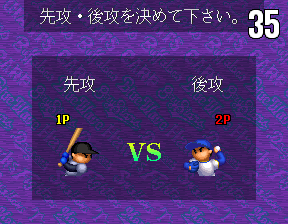
The game will then proceed to the new position selection screen, as the timer in the top-right corner of the screen continues counting down; it displays the Kanji texts senkō (先攻), which means batting first (1P), and kōkō (後攻), which means after the attack (2P) with one player from the first player's chosen team in his first outfit (holding his bat) and another player from the second player's chosen team in his second outfit (wearing his mitt) below them; either player can push their joystick to the right, to change that player from the first player's team into his second outfit (swapping his bat for a mitt), and the other player from the second player's team into his first outfit (swapping his mitt for a bat, the two Kanji texts will also swap positions), then push it back to the left after doing that to change them back to how they were before, before pressing the first button to confirm their choices. The game will then proceed onto its new team lineups screen - and each of the 96 players' names also have their abbreviated positions next to them, but the name next to the number 9 will once again always be tōshu (投手), which means "pitcher", with a "P" next to it, given that the game has not proceeded to the new pitcher selection screen yet. However, when it does, the timer in the top-right corner of the screen will still continue its counting down - and you will now have to select one of your chosen team's five pitchers (the static images of whom will no longer be displayed upon the screen, as you push your joystick up and down to highlight them), and if you had only pressed the 1 Player Start Button, the CPU will automatically select the first of its team's five pitchers to predetermine the behaviour of (it is not bothering to create the illusion of its random selection any more); all of the 60 pitchers' names now, for the first time since 1991, also have either the Kanji characters hidari (左) or migi (右) next to them which indicates whether they will pitch while facing to the left or the right. The game will then proceed to the stadium selection screen - and you now have to select one of the game's six new stadiums for your match to take place in (the third of them has been renamed from "Kōshien" and the fifth of them has been renamed from "Dome"), which all have different "centre" and "both wings" measurements (given in metres for all six of them)...
| Stadium | Name | Chūken (中堅) | Ryōyoku (両翼) |
|---|---|---|---|
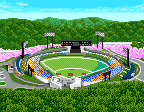
|
Hillside (ヒルサイド) | 120.0m | 95.0m |
| File:SS5 Trad Stadium.png | Trad (トラッド) | 120.0m | 90.9m |
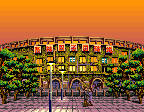
|
Urban (アーバン) | 118.1m | 96.0m |

|
Kaihei Dome (開閉ドーム) | 122.0m | 100.0m |
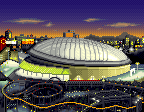
|
Air Dome (エアドーム) | 122.0m | 100.0m |
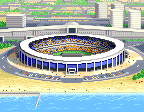
|
Seaside (シーサイド) | 122.0m | 99.5m |
...and once you have pressed the first button to confirm your choice, the screen will fade out before fading back into a shot of the sky above your chosen stadium. The camera will then pan down to the field of the stadium as all eighteen players (and all six umpires) run out and take their positions on it, and both of your chosen teams' logos will then fly into view from the left and right sides of the screen, as a "VS" appears between them; that Hillside Stadium features an advertisement for Starblade, that Trad Stadium features two advertisements for Mappy, a third for Pac-Land, and two murals of a Pooka and a Fygar from Dig Dug, that Urban (Kōshien for old players) Stadium features six advertisements for Great Sluggers, Outfoxies, Tekken, Xevious, Mappy, and Dig Dug (however, back in the NS2 era, it featured an advertisement for SOS) and that Kaihei Dome Stadium features advertisements for Pac-Man, Ace Driver, Galaga, Outfoxies, Mach Breakers, Tekken, and Midway Games' first unauthorised Pac-Man sequel Ms. Pac-Man. The match will then start.

The view will now change to a shot of the centre of the stadium's field, as the Katakana text purei bōru (プレイボール), which means "play ball", flies into view from the right side of the screen and disappears off the left one; the score will now be displayed up in the top-right corner of the screen (with the batting team's initial underlined in red) under the number of 1 and the two Kanji characters of kai omote (回表), which means "front time". The statistics of the No. 1 from that first player's team will again be displayed in that bottom-left corner of the screen below that team's initial - and the statistics of the chosen pitcher from that second player's team will also be displayed in the bottom-right corner of the screen below the team's initial. The first player must use his joystick to position his batter inside that batting box, and the second player must push his joystick to the left or right to position his pitcher upon the pitcher's mound, then press his first button to throw the ball; he must now push the joystick to the left if he wants the ball to curve horizontally, down-left if he wants it to curve vertically, right to shoot horizontally, down-right to shoot vertically, down to fork and up to be a speed ball. If the other player's team's current batter failed to hit it, the Katakana text of sutoraiku (ストライク), which means "strike", will appear upon the screen, with the speed at which that ball travelled in kilometres above it, as a yellow circle appears next to the letter "S" on the left side of the screen - and you both then have to repeat the pitching process, but if the other player's team's current batter fails to strike the ball again, the Katakana text sutoraiku (ストライク) will again appear on the screen, with the speed at which the ball travelled in kilometres above it, as a second yellow circle appears. You will both then have to repeat that pitching process again, but if the other player's team's current batter fails to hit that ball once again, the Katakana text battā auto (バッターアウト) which means "batter out", will appear upon the screen (with the speed at which the ball had travelled in kilometres above it), as both yellow circles next to the letter "S" disappear and an orange circle appears next to the letter "O" below it and the other player's team's next batter is brought in; he will have different statistics. Those text boxes that were introduced in Super World Stadium '93 will also reappear on the left side of the screen: Heisatsu-da (併殺打), which means: "hitting double play", Hitto (ヒット), which means "hit", Niruida (二塁打), which means: "two-based hit", Sanruida (三塁打), which means "three-based hit", Honruida (本塁打), which means "home run", Gifurai (犠フライ), which means "sacrifice fly", Gibanto (犠バント), which means: "sacrifice bunt", Shikyū (死球/四球), which means "dead ball" or "walk", Uchifurai (内フライ), which means "fly in", Uchigoro (内ゴロ), which means "grounder in", Sotofurai (外フライ), which means "fly out", Sotogoro (外ゴロ), which means "grounder out", Funige (振逃げ), which means: "shake relief", Shissaku (失策, which means "mistake", and Yasen (野選), which for a second time only means what it is read as.
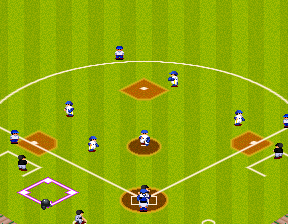
The first player must press the first button to make his batter swing and the second button to make him bunt; once he has struck the ball, the view will change to a shot of your stadium's field as it flies up into the air. If the ball does not land within the white lines, the umpires (of which there are six) will hold their arms up and the Katakana text fauru (ファウル), which means "foul", will appear upon the screen and it will be counted as a strike - this will also be signified by a yellow circle appearing next to that letter "S", once the view returns to the image you see above. Also, if the current batter hits the ball so hard that it flies out of the stadium, the Katakana text hōmu ran (ホームラン), which means "home run", will appear upon the screen with the distance that the ball travelled in metres next to the Kanji text hikyori (飛距離), which means "flying distance", and the Katakana (or Kanji) text for where the ball landed (レフトスタンド: "left stand", バックスクリーン: "back screen", ライトスタンド: "right stand", ラッキーゾーン: "lucky zones" for the Urban Stadium, and 場外: "curb", in all except for the Kaihei Dome and Air Dome Stadiums), below it; the current score will then be displayed upon the screen (the teams are still represented by their logos), as a window rotates into view at the bottom of the screen showing your chosen team's players running around the bases as their mascot(s) cheer them on (and if you'd chosen to take control of either the Yomiuri Giants or Hanshin Tigers, you will have the chance to see their secondary mascots, "Sister Giabbit" and "To Lucky"). If the ball landed within the white lines after your chosen team's current batter hit it and one of the other players on your chosen team caught it as it fell back down to the ground, you will have to press the first button to make him throw it to one of the other players while pushing the joystick up and down to indicate which player you want him to throw it to; once you have done so, all the umpires will either hold their arms out, and the Katakana text of sēfu (セーフ), which means "safe", will appear on the screen if the player was safe, or they'll hold their right arms up, and the different Katakana text of auto (アウト), which means "out", will appear on the screen if he was out (yet again, this will also be counted as an out, and it will be reflected by one orange circle appearing next to the letter "O" once the view has returned to that screenshot you see above). The radar of the field which now appears down in the bottom-left corner of the screen shows the positions of that other team's players (indicated by the moving hats, which still match the colours of their own) - and when your team is batting and the other player's team is pitching, push your joystick up and press the first button to tag out a runner on the other player's team who is attempting to steal a base (they can still be seen in the windows, on the left and right sides of the screen). Once you have done so, the runner will run out of sight from the left side of the screen, as the other player's team's chosen pitcher throws the ball; once your team's current batter has struck on the ball, the view will again change to a shot of the field as it flies up into the air, but the other player's team's chosen pitcher will then run off the pitcher's mound, and onto the catcher's plate. You will now have to push your joystick to the left and press your first button to make your chosen team's runner start running, then push your joystick up, and press your second button to make him run back again - and once three outs have occurred, the view will cut to an overhead shot of your chosen stadium (in all except that of the Hillside Stadium, there will also be crowds cheering) with a scoreboard at the top of the screen and a list of the next three batters on the right side of the screen (or the left side of the screen, if it is the first player's turn to bat again). The match will then continue.
-
The Yomiuri Giants' secondary mascot, "Sister Giabbit".
-
The Hanshin Tigers' secondary mascot, "To Lucky".

